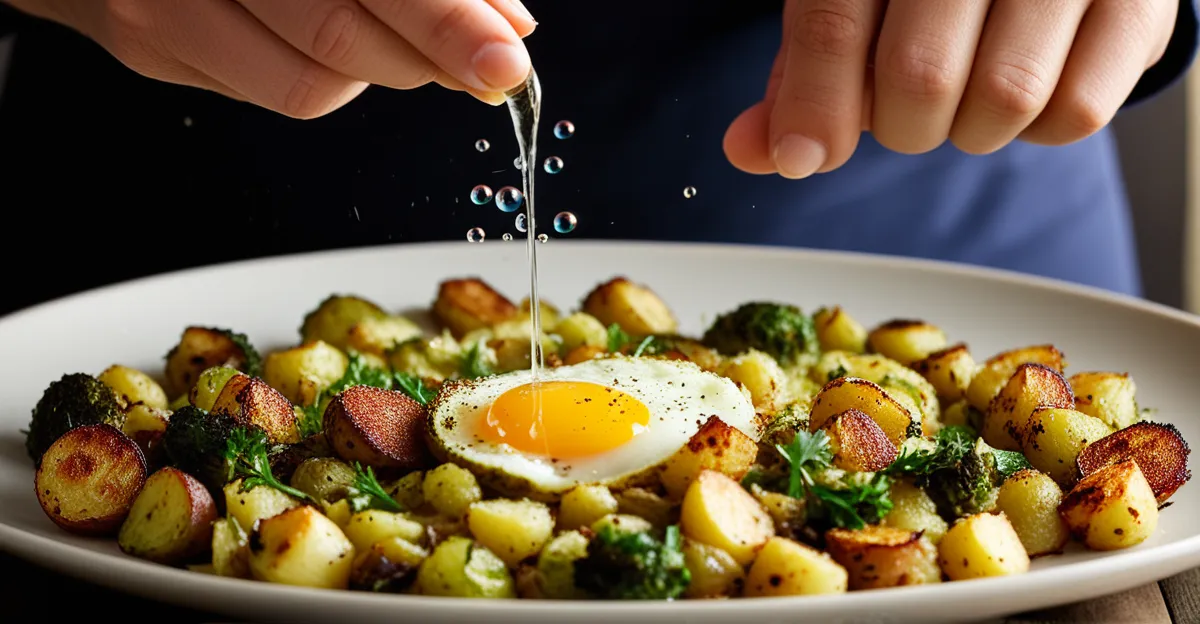Essential Ingredients and Preparation
Understanding the core bubble and squeak ingredients is crucial to mastering this classic dish. Traditionally, the recipe features mashed potatoes and leftover vegetables, often including cabbage, carrots, and peas. Modern twists may incorporate additional vegetables like Brussels sprouts or kale, layering flavors while maintaining the dish’s essence. Using a balanced mix of starchy potatoes and varied vegetables provides both texture and flavor, essential for a satisfying outcome.
When it comes to bubble and squeak preparation, the quality of your mashed potatoes and vegetables plays a significant role. Potatoes should be well-cooked and mashed smoothly but not overly wet, as excess moisture can affect the crispiness. The leftover vegetables should be chopped finely and cooked until tender, ensuring they blend well with the potatoes during frying.
This might interest you : How can you create a delicious toad in the hole at home?
For convenience without sacrificing taste, using leftover vegetables from previous meals is an excellent strategy. This not only saves time but also enhances the flavor complexity as the mixture benefits from the natural seasoning that develops in leftovers. Preparing the ingredients by sautéing or roasting them briefly before combining can add depth, making the final dish more colorful and flavorful.
Step-by-Step Bubble and Squeak Recipe
Mastering the bubble and squeak recipe begins with preparing the ingredients correctly and following clear cooking instructions. Start by ensuring your mashed potatoes and leftover vegetables are ready, keeping in mind the advice from the preparation stage.
In the same genre : How Can British Cooking Traditions Influence Modern Culinary Trends?
To make bubble and squeak, first combine the mashed potatoes with chopped leftover vegetables in a bowl. Mix thoroughly to create a consistent mixture that will hold together during cooking. Heat a non-stick frying pan over medium heat and add a small amount of oil or butter. Spoon the mixture into the pan, shaping it into patties or pressing into a single flat cake—both methods work depending on preference.
Cooking temperature is crucial for the ideal crunch without burning. Cook the bubble and squeak on medium heat to allow the outside to crisp up while the inside remains soft. After about 5-7 minutes, once the underside forms a golden crust, carefully flip to cook the other side for another 5 minutes or until both sides are browned and crispy.
For those wondering how to make bubble and squeak in advance, the mixture can be shaped into patties and refrigerated. When ready to serve, cook straight from the fridge, extending the cooking time slightly to ensure the middle is heated through. This method supports batch preparation, making it a convenient option for busy households.
In summary, a well-executed bubble and squeak recipe depends on prepped mashed potatoes and vegetables, controlled heat, and careful cooking time for that perfect balance of texture and flavor.
Tips for Enhanced Flavour and Texture
Enhancing the bubble and squeak flavour starts with thoughtful seasoning during the bubble and squeak preparation stage. Adding salt and freshly ground black pepper to the mixture of mashed potatoes and leftover vegetables is fundamental. Beyond the basics, incorporating herbs like thyme, rosemary, or parsley infuses aromatic layers that elevate the dish. A pinch of nutmeg or mustard powder can subtly boost the savoury profile without overpowering the traditional taste.
Achieving the coveted bubble and squeak crispy texture requires precise control over heat and moisture. Ensuring the mashed potatoes are not too wet is the first step; any excess moisture can create steam, preventing the exterior from crisping properly. When frying, medium heat is optimal to brown the outside gradually, allowing a firm crust to develop while keeping the inside tender and warm. Flipping the patties only once or twice minimizes breakage and helps maintain the crisp surface.
Seasoning bubble and squeak during and after cooking can enhance the complexity of flavours. A splash of Worcestershire sauce or a drizzle of malt vinegar adds tang and depth. For those seeking creaminess, topping the finished dish with a dollop of sour cream or a sprinkle of grated mature cheddar introduces both texture and richness. Experimenting with crushed garlic or caramelised onions folded into the mixture can also intensify the flavour while maintaining the classic essence.
In summary, mastering bubble and squeak flavour tips revolves around judicious seasoning, moisture control in mashed potatoes and leftover vegetables, and carefully timed cooking to develop that irresistible crispy outside and soft middle combination.
Ingredient Variations and Dietary Options
Exploring bubble and squeak variations opens up opportunities to tailor this classic to diverse dietary needs and preferences. Traditional bubble and squeak ingredients revolve around mashed potatoes and leftover vegetables, but swapping or adding vegetables can introduce new textures and flavours. For instance, incorporating sweet potatoes or butternut squash offers a subtle sweetness, while adding mushrooms or leeks can deepen the umami profile. Leafy greens like spinach or kale not only boost nutrition but also complement the familiar taste and texture.
For those seeking a vegetarian bubble and squeak, the dish is naturally suitable as it primarily includes vegetables and potatoes. Enhancements can come from added cheeses, such as mature cheddar or vegetarian-friendly vegan cheeses, ensuring richness without compromising vegetarian principles. To create a vegan bubble and squeak, traditional butter can be replaced with plant-based oils or vegan spreads, and avoid cheeses. Ensuring the bubble and squeak preparation excludes animal-derived products makes this dish accessible to a broader audience without losing its essence.
In situations requiring a gluten-free bubble and squeak, the classic recipe is inherently gluten-free when prepared with plain potatoes and vegetables, free from any flour or breadcrumbs additives. However, caution is advised if additional ingredients like pre-seasoned sauces or processed toppings are used; always verify gluten-free certification to avoid unwanted allergens.
Regional twists further enrich the variations, with options like adding cooked bacon or sausage for meat lovers, or mixing in fresh herbs such as chives and parsley providing bright, fresh notes. These substitutions and additions allow bubble and squeak ingredients to evolve beyond leftovers into a versatile dish suitable for many palates and diets, maintaining the balance between flavour, texture, and nutritional needs.
Serving Suggestions and Presentation
Enhancing the enjoyment of bubble and squeak extends beyond cooking; thoughtful serving bubble and squeak can elevate the meal experience. Serving this dish alongside hearty breakfast classics such as fried eggs or grilled sausages creates a balanced and satisfying plate, ideal for brunch or a comforting dinner. For lighter options, pairing bubble and squeak with a fresh green salad or steamed vegetables adds a vibrant contrast in texture and flavour.
When considering bubble and squeak accompaniments, traditional condiments like Worcestershire sauce or malt vinegar bring tanginess that cuts through the richness, enriching the overall taste profile. Alternatively, a dollop of sour cream or a spoonful of applesauce introduces creamy or fruity notes that complement the crispy mashed potato and vegetable base. For those preferring a bit of heat, mustard or hot sauce can also be excellent partners, adding a lively kick.
Presentation plays a crucial role in making bubble and squeak appealing. Serving patties neatly arranged on a warm plate with a sprinkle of fresh herbs like parsley or chives not only adds colour but also enhances aroma and freshness. Using individual ramekins or stacking smaller cakes can create an elegant look, perfect for guests or special occasions.
Leftover bubble and squeak also lends itself well to creative meal planning. Reheated slices make excellent sandwich fillings or a base for a breakfast bake, demonstrating the dish’s versatility. By varying the accompaniments and presentation, you can transform this humble dish into a versatile meal suited to diverse dining preferences.


Comments are closed